- Home
- Technical Cooperation Projects
- Index of Countries
- Africa
- Ghana
- Project for Improving Continuum of Care for Mothers and Children through the introduction of Combined MCH Record Book
- Project News
- The first Monitoring and Supervision in 10 regions
Project News
2019-03-31
The first Monitoring and Supervision in 10 regions
In 2018, a series of Training of Trainers (ToT) on the effective use of MCHRB was conducted in all 10 regions resulting in 869 national, regional and district facilitators trained (See the project news ‘Training of District Level Trainers on the New Combined Maternal and Child Health Record Book in all 10 regions of Ghana'). The facilitators were expected to conduct a series of downstream training for health workers in all health facilities. The first Monitoring and Supervision (M&S) was conducted in all 10 regions in the first quarter of 2019 to assess the status of implementation.
The objectives of the M&S are 1) to assess the use of MCH RB by health workers, 2) to strengthen the capacity of health workers on the effective use of the book and 3) to document best practices and challenges to improve the MCH RB implementation.
Methodology
A monitoring team comprised a National facilitator, Regional facilitator, District facilitator and staff of the MCH RB Project. In each region, the monitoring teams visited the Regional Health Directorate (RHD), three District Health Directorates (DHD) and an average of nine health facilities within one week. At the first M&S, the monitoring teams visited 10 RHDs, 34 DHDs and 95 health facilities in 10 regions from January to March 2019.
Before starting the M&S, checklists were developed for all three administrative levels: regions, districts and facilities. There were a series of questions on logistics for MCHRB services and the status of training in the checklists. In addition to administrative points, the checklist at facility level included sections to check skills and knowledge of health workers and the level of understanding among clients. Especially, new skills/services introduced with MCH RB are carefully observed such as BMI calculation, nutrition counseling and length measurement. On-site-coaching was provided at the M&S as an opportunity for health workers to improve their capacities on the effective use of the book with newly introduced skills and services.
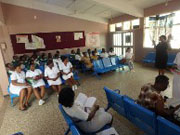 National facilitator coaching health workers after M&S.
National facilitator coaching health workers after M&S.
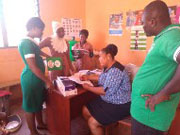 National facilitator providing feedback for health workers
National facilitator providing feedback for health workers
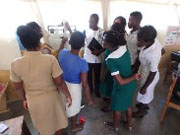 Observing how to measure weight correctly
Observing how to measure weight correctly
Results
- Out of 95 facilities visited, 82% were using MCH RB.
- The supply of MCH RB was not enough for the eligible population in the country although 1.2 million books were printed.
- Necessary items to utilize MCH RB such as length board, star stamp and User Guide were not enough for health facilities.
- Poor logistic management was observed. A reported number of MCH RB received in regions was significantly different from the number of actual distributions. (Figure 1) Only 39 facilities (41%) had a tally card for MCH RB.
 Figure 1: Reported number of distributions by national and received number by region
Figure 1: Reported number of distributions by national and received number by region
- Out of 34 districts visited, 25 districts (73%) conducted training for all facilities in the district. While 91% of midwives at CHPS[1] level were trained, only 61% at the hospitals had received training.
- Incomplete and/or inaccurate recording of MCH RB was observed
- Many health workers did not conduct health/nutrition counseling appropriately.
Good practices
Several good practices were found during the first M&S.
- In Brong Ahafo Region, for easy track and monitoring of the books, RHD was taking the initiative to code the consignments of books.
- In Upper East Region, strong teamwork between Nutrition unit and Reproductive and Child Health unit was observed at the Regional Hospital, ensuring that nutritionists were always available during Antenatal Care (ANC) and Child Welfare Clinic[2] for nutrition counseling and follow-up.
- Star stamps were reproduced at several districts by an internally generated fund (IGF).
- In Nadowli-Kaleo District of Upper West Region, the District made a sub-reference book which explained how to calculate the Estimated Date of Delivery and Body Mass Index.
- Copied page of BMI and Desired Weight calculation in the User Guide was placed on the wall of ANC room; strategically posted as for easy reference at some facilities.
- In three districts of Volta Region, facilitators took the opportunity of the meetings, report submission occasion and/or at other training to introduce the book and the usage.
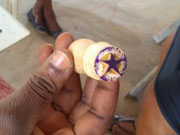 Star stamps made by an IGF
Star stamps made by an IGF
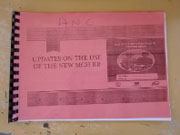 Sub-reference book in Nadowli-Kaleo district
Sub-reference book in Nadowli-Kaleo district
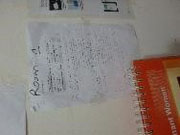 The page of BMI and Desired Weight calculation was pasted on the wall of an ANC room
The page of BMI and Desired Weight calculation was pasted on the wall of an ANC room
Way forward
The project is planning to conduct a series of training for staff at major hospitals, as the results show there are many untrained midwives in hospitals. Also, Audio-Visual Learning Aid will be developed to provide a self-learning opportunity for health workers. The second M&S will be conducted in 2020 and we hope to see better results.
Notes
- [1] Community-based Health Planning and Services (CHPS) is a community-based approach to provide basic health services nationwide in cooperation with the Ghanaian government, local communities, and their leaders.
- [2] Child Welfare Clinic is a service that allows parents to have babies and children under 5 years get weighed, measured length and immunized. Health/nutrition couseling is also provided.
- About JICA
- News & Features
- Countries & Regions
- Our Work
- Thematic Issues
- Types of Assistance
- Partnerships with Other Development Partners
- Climate Change / Environmental and Social Considerations
- Evaluations
- Compliance and Anti-corruption
- Science and Technology Cooperation on Global Issues
- Research
- JICA Development Studies Program / JICA Chair
- Support for the Acceptance of Foreign HRs / Multicultural and Inclusive Community
- Publications
- Investor Relations
